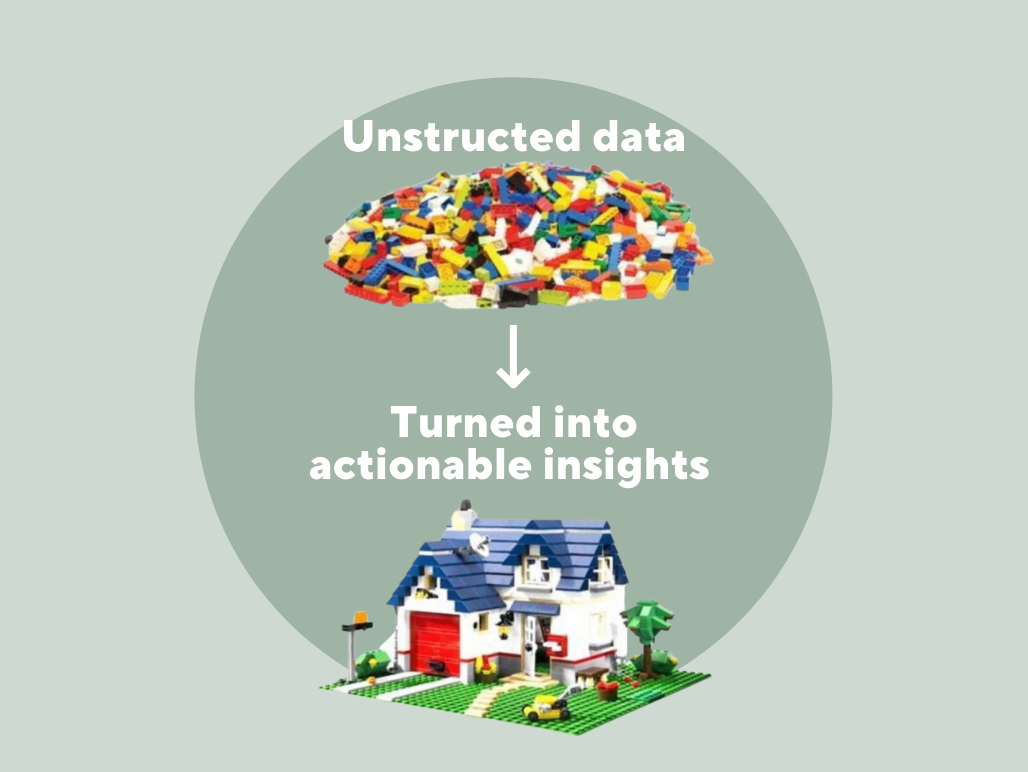But while data analytics adoption has grown in general, many industries, and even individual departments within a company, are still cut off from advanced data insights. Often, this is because their data is largely in the form of unstructured data, which is more challenging to process.
In this post we will discuss the value of mining unstructured data and the best ways to go about it. But before you can start the process, you need to understand what is unstructured data and why the barrier to entry is so high.
What types of data are there?
The three types of data
There are essentially two types of data: structured data, and unstructured data, although people also often refer to a third kind, semi-structured data, which lies between the two.
Structured data
Structured data refers to information in defined fields, usually in a relational database like an Excel spreadsheet. You can think of it as quantitative data, and it’s restricted in both length and content.
Structured data sets are typically numerical, like phone numbers, SSNs, zip codes, and latitude and longitude coordinates, but they can also be simple text, like names and addresses.
Unstructured data
Unstructured data is found in undefined fields rather than a relational database, without any tags or hierarchies. It’s qualitative data that doesn’t fit neatly into a spreadsheet.
Examples of unstructured data include voice notes, images, text messages, emails, blog posts, social media posts, photos, videos, contracts, animations, and live web chats. Unstructured data, vs. structured data, doesn’t have any restrictions and can include vast amounts of data and content.
Semi-structured data
As the name suggests, semi-structured data is neither structured data, nor unstructured data. It can’t fit into a relational database like structured data, but it also has some hierarchies and/or semantic tags, which unstructured data lacks. The Hubspot team explains it as “information that does not reside in a relational database or any other data table, but nonetheless has some organizational properties to make it easier to analyze, such as semantic tags.”
Examples of semi structured data include HTML code, email addresses, CSV, XML and JSON documents, NoSQL databases, and electronic data interchange (EDI).
Why does unstructured data matter?
When we talk about big data and the potential it has for analytics and businesses, we’re mostly talking about unstructured data. Most big data – around 80% to 90% of it – is unstructured, and it’s increasing rapidly.

Unstructured data is simply far bigger than structured data could ever be. There can be more information in a single emoji than in 5 lines of a database. Voice notes, for example, contain not just words, but also tone, speed, context, volume, etc. all of which hold valuable information about how the speaker feels. If you ignore unstructured data, you’re ignoring all of this.
You could think of structured data as the “what,” and unstructured as the “why.” When you combine the two, you’ll inevitably uncover more useful insights than if you consider either of them alone. When businesses ignore unstructured data, they become like the hidden rocks beneath the surface of the water.
Emotions and sentiment cannot be structured, but they are the information businesses really want to discover. For example, data scraping extracts readable data from another computer system. Perhaps a VC fund is scraping data about software companies to profile them for potential investment. The computers need a way to distinguish between the actual data (which could be structured or unstructured), and the interchange between the computer systems (which is structured data), and then to clean the unstructured data and analyze it. The fund may need structured data about revenue, profit and loss, etc. as well as unstructured data in the form of key personnel bios, and the comments left by beta users in forums.
Finally, unstructured data matters because it remains largely untapped. The sooner a company mines the value of this data, the more they can sharpen their competitive edge. Mikey Shulman, a finance lecturer at MIT Sloan and head of machine learning at Kensho, which specializes in artificial intelligence and analytics for the finance and U.S. intelligence communities, points out that “Because structured data is easier to work with, companies have already been able to do a lot with it. But since most of the world’s data, including most real-time data, is unstructured, an ability to analyze and act on it presents a big opportunity.”
What is unstructured data management?
It’s difficult to manage unstructured data, and that creates a barrier to extracting value from it. It’s not easy to search it or organize it into categories. Managing unstructured data requires human input, but manual analysis isn’t powerful enough to cope with the flood of big data.
That’s why people turn to a data management platform for unstructured data analytics. These platforms are tools to gather the data and convert it into actionable insights that businesses can put to use.
There’s a common saying today that “data is the new oil,” but like oil, raw data cannot be used as fuel unless it is refined. Unstructured data management effectively refines the raw, unstructured data into actionable insights that can drive business decision-making.
Tapping into the value of unstructured data
Since human intelligence isn’t vast enough to analyze unstructured data, you need to use artificial intelligence (AI) in the form of machine learning (ML). Data scientists develop a ML algorithm to create a data model using a number of possible techniques. The most common ML approach is natural language processing (NLP) or deep neural networks for deep learning (DL).
The data management system gathers data from all the relevant data sources, such as all social media channels, review sites, emails, live chatbots, text messages. Some data management platforms integrate directly with tools like Google sheets, Zapier, Zendesk, etc. or have integrated web scraper tools.
The analytics tools then clean the data to remove irrelevancies like ad banners (unless you’re looking to analyze ads, of course) and errors like spelling mistakes, but they need to retain metadata like the date when a photo was taken or the location of the person posting a comment, because this context is important in helping guide the accuracy of the data analysis.
DL or NLP techniques are then applied to analyze the meaning of the data. It takes time, but once the algorithm is trained accurately, it can efficiently gather relevant data and recognize what is encoded within it.
The AI data analysis compares datasets with each other, looking for patterns, key differences, etc. that reveal meaning, and using various data preparation techniques to turn unstructured data into a format that machines can understand. Data scientists build a data model using training data first, teaching it how to recognize patterns that indicate certain types of reaction, sentiment, opinion, etc.
It’s a similar story for image analysis. The algorithm is trained to see patterns between images so it can recognize the shapes within the image. This is true for a wide range of image data analytics, including MRI scans, autonomous vehicles that recognize obstacles in the road, or social media analysis recognizing a “smiley” reaction.
Different AI analytics techniques include:
Sentiment analysis that extracts basic sentiment such as positive, negative, and neutral;
Keyword extraction that identifies the most important keywords, recurring themes, and overall topics;
Intent and email classification that understands the intent of a comment or query.
A data management platform typically includes data visualization, which makes it easy for humans to derive meaning from data insights at a glance. Some enterprises are taking it a step further, and using AI to produce actionable insights, predictions, and recommendations from the output of the unstructured data analysis.
What value can you gain from unstructured data?
In today’s world, customers respond to brands that respond to them, but that’s difficult to do if you don’t know what your customers are thinking or feeling. Brands need unstructured data analytics for a number of reasons.

Create a business strategy
With unstructured data management, you can discover which markets to address next and which threats are on the horizon, so you can adjust your sales forecasts, risk assessments, and finance predictions accordingly.
Unstructured data management isn’t only relevant outside the company; use it on internal employee data to identify which employees are thinking of leaving the company, and take action to retain them.
Refine marketing campaigns and messaging
When you understand your leads’ pain points and concerns, you can create a far more effective lead nurture process. Use data insights to offer the right product, service, or recommendation to the right customer at the right time.
Deep AI-powered data analytics enable personalization on a granular level. For example, a bank might see that a customer’s child, who has a joint account, is moving away to college. The bank can then offer the customer financing options to help them with this expense, or renter’s insurance for that town.
Enhance customer experience
Customer experience is the driving factor in retaining or losing customers, but it’s a struggle to improve it without visibility. Unstructured data analysis reveals weak points in customer service and interactions so you can raise your standards.
ML analysis like social media data analytics help you identify negative mentions so you can prioritize them for attention, giving customers a better customer experience without leaving them waiting for a long time.
For fintech companies, for instance, this is extremely important; customers can easily grow frightened and angry when they feel their money might be at risk. Online trading and investment companies need a system in place that will alert and prioritize negative mentions, to prevent a possible PR crisis.
Improve the product
Every company wants to know which of their product’s features are the most appreciated, what aspects are confusing, what doesn’t add value and what does, etc. With unstructured data gathered from social media, surveys, or review sites, you can assess consumer sentiment to guide your product decisions.
For example, gaming companies rely on forums such as Vanilla and Discord to show if the changes they’ve made to their games are being accepted positively or negatively. By gathering these insights, they can make efficient product decisions for the next release.
Reveal customer expectations
Businesses need to know customer demands, emerging trends and fads so they can keep their product and messaging relevant. It’s particularly needed in consumer retail and high-fashion clothing, where trends move fast and you can easily get left behind. Ecommerce outlets, for instance, need to know which products will be in demand for the winter holiday season, and they need to know it early enough so they can place their orders in time.
Streamline operations
Every business has unnecessary costs and expenses which can be trimmed to make the enterprise more efficient. Unstructured data helps uncover inefficiencies and overlaps within the organization so you can bolster profit margins. Unstructured data can also provide insights about your supply chain, so you can track the progress, speed, volume, and conditions of shipments and make better decisions.
Why do you need a data management platform?
A data management system is vital to convert unstructured data into actionable insights that you can use to boost productivity and profitability. The right platform helps you save time and resources by gathering data for you, creating a better strategy and business process for it, and delivering insights that you can use in any part of the company.
Without the help of a management platform, most enterprises wouldn’t be aware of the content of the majority of their unstructured data, because it’s mainly from third party assets like social media or reviews, or buried deep in the text of trouble tickets. You wouldn’t have a chance to discover these sentiments without unstructured data management tools.
How Affogata can help with unstructured data analysis
Affogata’s cloud based data management platform offers a number of capabilities to help brands collect unstructured data and turn it into actionable insights that guide business growth.
Data gathering from all channels, including review sites, social media, customer forums, emails, live chat, messaging, etc. which are sometimes overlooked;
Real time data is constantly updated so it’s always relevant;
Data storage in data lakes that remove silos and ensure it can all be accessed by the Affogata analytics engine;
Guidance through the data jungle, with our AI which tracks every direct and indirect mention;
Segmentation for mentions by topics, keywords, and sentiment for easy understanding;
A single cross-organizational platform to analyze all your data and produce actionable insights for product, marketing, social media management, developers, business intelligence, and other departments;
Automated alerts when there’s a PR crisis, so you can act fast to prevent it snowballing;
Integration with existing business intelligence tools and data sources through an open API.
You can use Affogata to gain crucial customer insights from unstructured data that’s waiting for you across the entire web as well as your internal data sources, insights that will help you refine business strategy and raise customer satisfaction to drive growth. Request a demo of Affogata to learn how it can benefit your business today.
